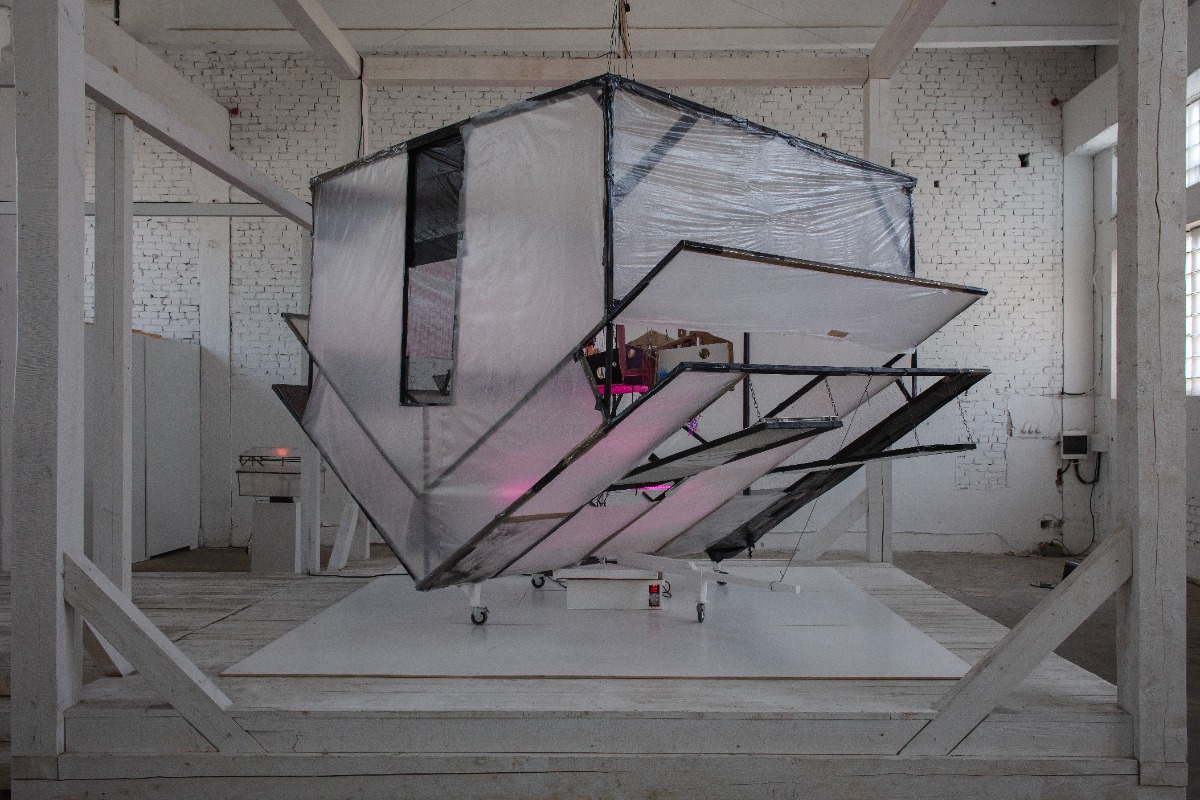
Shelter
Viktoria Weber, TUR_telpa
An interview with artist Bas de Boer about his current exhibition “Shelter” (29.05. – 29.06.2024) at TUR_telpa
Bas de Boer graduated from the Academy of Fine Arts in The Hague in 2003 and has since maintained a studio practice in the city. He’s a founding member of the contemporary art space 1646 and the creative hub Maakhaven, both in The Hague, and has regularly been visiting Latvia for the last 14 years. His exhibition “Shelter” (29.05. – 29.06.2024) at TUR_telpa is the result of an artist residency in which de Boer explores dystopian scale models that extend into concerns of both a global and personal scale. The ongoing housing crisis in the Netherlands becomes a metaphor and example of the insecure state of the world. Through his installation and his visual vocabulary of scale models of varying sizes and flimsy greenhouses, the artist is questioning a lack of protection and comfort in our increasingly dystopian reality.
Viktoria Weber: You’ve been to Latvia multiple times already for different residencies, like with Kim? in 2010 or with Free Riga in 2019 before now being an artist-in-residency in TUR. For your exhibition in Kim? in 2010, you decided to construct this enormous cuckoo’s clock that was described as a symbol of domesticity and regularity; it evokes thoughts of home but also of souvenirs. At the same time, cuckoos are parasites that lay their eggs in other birds’ nests. So in a way, you may have critically compared artist residencies to the breeding habits of these birds of kicking out other eggs to lay their own. So now you have been revisiting Riga over and over again, not only for residencies but also to just visit friends and travel around. How does this shape your perception of artist residencies? Do you feel like a cuckoo in the city?
Bas de Boer: It was a bit of a comment on the situation, because I was asked to do this residency. It was not something I thought about, to be honest, myself. But I was asked by Rob Knijn from Heden in The Hague to go on a residency. And they paid for everything, which was very nice. But at the same time, the art funding in the Netherlands is quite good, better than in Latvia.
So I did feel a little bit like somebody that was well subsidised going to a place where people are maybe less lucky and there isn’t or less of this this whole structure around financing arts. So I wanted to comment on my personal situation because I also felt a bit weird about going to a place that well – I didn’t know Latvia well before coming. That has to do with the fact that I come from a Western world where everything behind the curtain back then was still Soviet. Our worldview was always directed to the West and never to the East. I felt a little bit like an intruder who just came here with the money in his pocket and had the opportunity to do stuff that maybe people from here couldn’t do. In that sense, the work was personal, about my own stay.
Bas de Boer, “Cuckoo” (03.07. – 01.08.2010) at Kim? Photo: Bas de Boer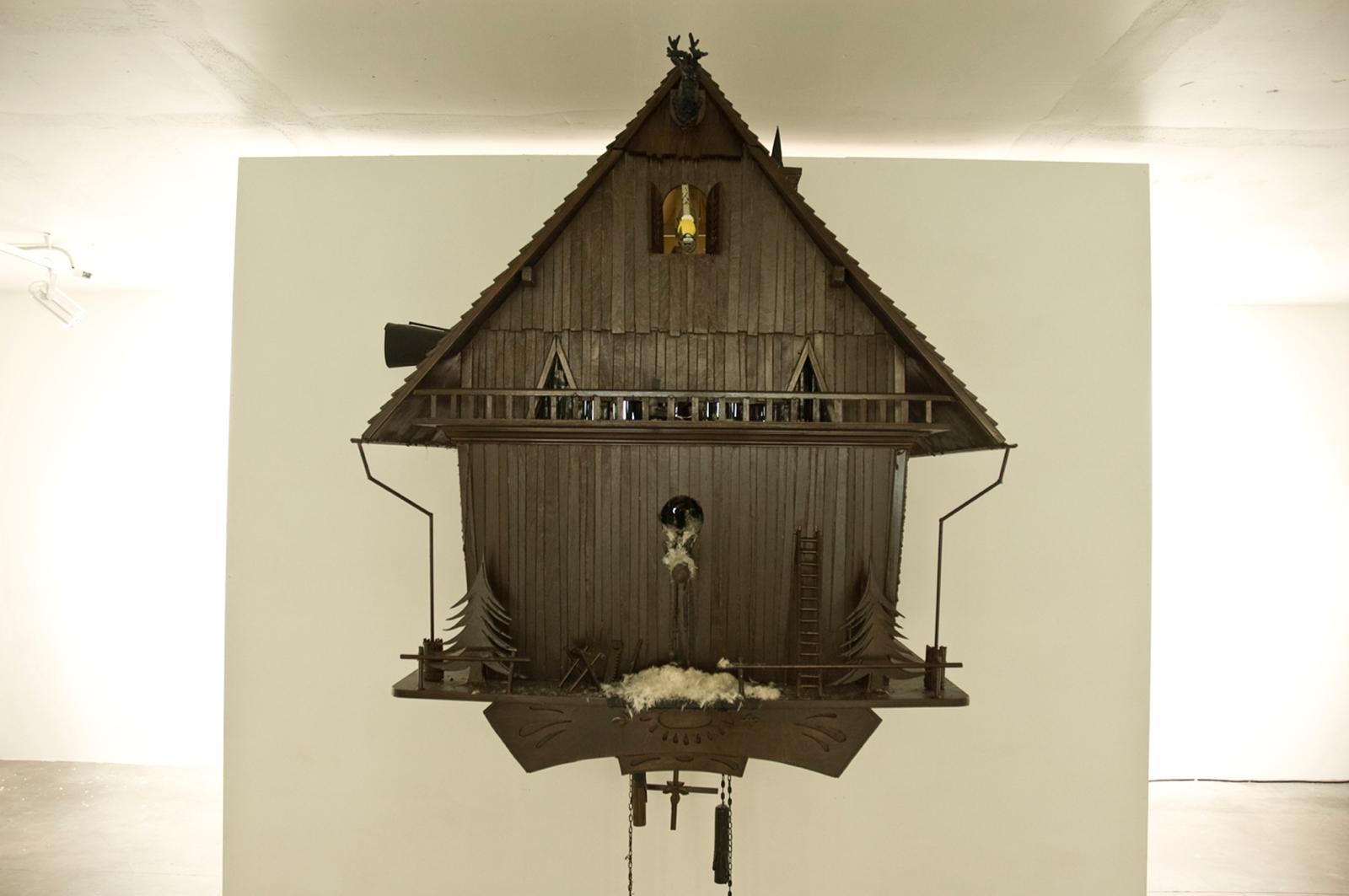
VW: Do you still feel a bit like an intruder?
BdB: No, no, no. Because then I really wanted to do something with the fact that I didn’t know the place, and I was sort of just put here in this luxury position. I felt a bit like a cuckoo in that sense, but I don’t have that anymore because I come here for 14 years and I really appreciate Latvian culture and Riga. And I have a few, I would say, good friends here now, which I really appreciate. It’s always a warm welcome. I fell in love with Latvia, and like to come here. The whole vibe and the city, but also especially the countryside which, because of my friends who live in the countryside, I also have the opportunity to see. It’s amazing ... I really love to come back. It was not love at first sight, but it grew on me, and then it became something that I really appreciated.
It’s funny. I was talking with my friends yesterday who came to visit me from the Netherlands, and they also really understood this attraction. The architecture … Riga is a beautiful city. And the friends I have here are so sweet. It’s really easy. It’s really different from where I come from. I think the Netherlands are a bit more ... there’s another vibe. Sometimes there is more aggression. The pace of life is different. We have a lot of people in a very small territory. So it does something with people, I think.
VW: It sounds like you found a second home in Riga, or at least a comfortable place to stay.
BdB: Yeah, but for me, it’s not about the place; it’s mainly about the people. The fact that I made friends here is why I want to return. Because if I were to see Latvia as a tourist, I don’t think it would appeal to me in that sense. But once you really start to know people who live here and become friends, you visit places - like not in old town - but the real places that I would like to go to and explore. In that sense, it became a second home, but mainly because of the people.
Bas de Boer, “Shelter” (29.05. – 29.05.2024) at TUR_telpa. Photo: Kristīne Madjare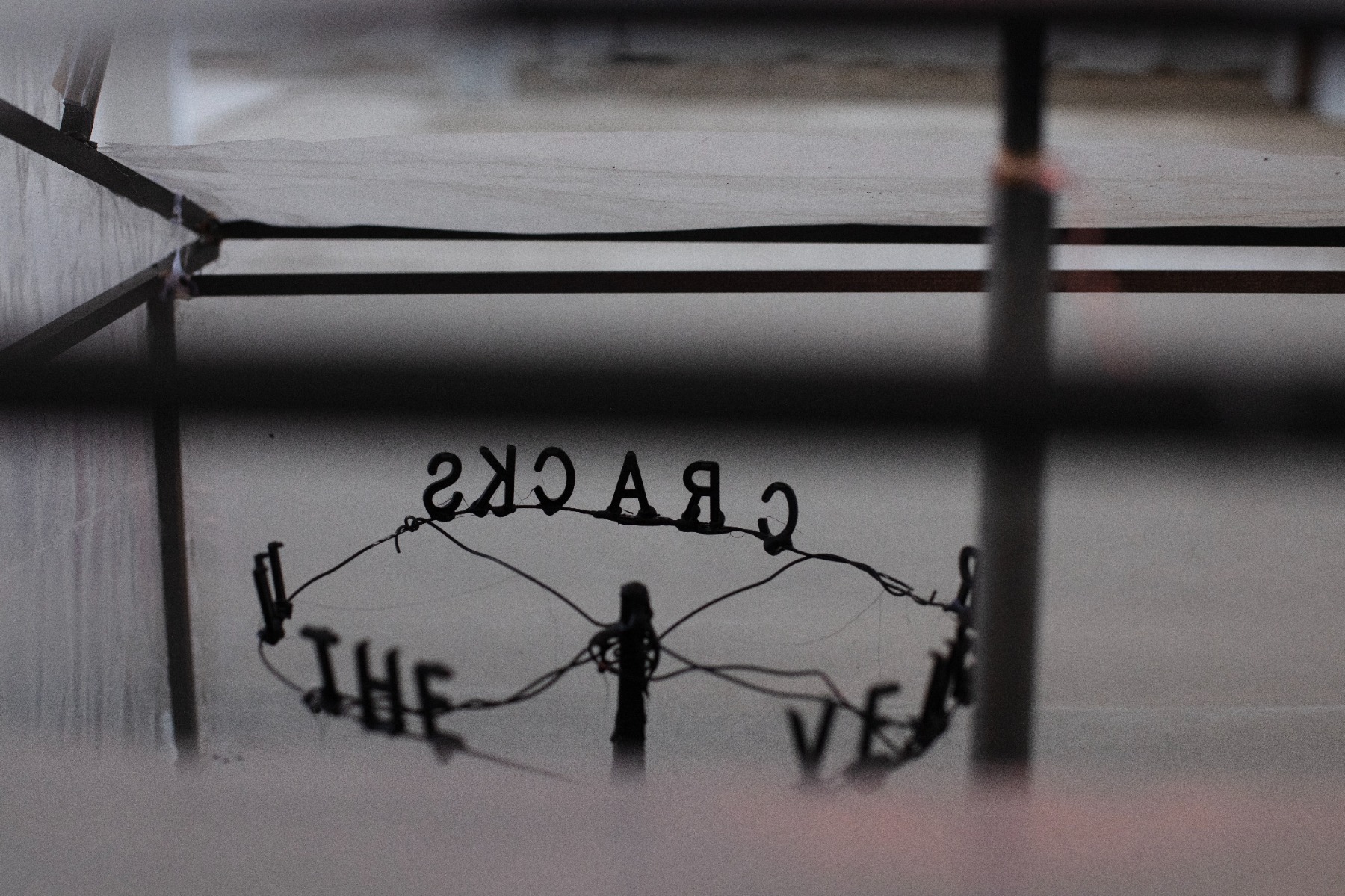
VW: Your current show in TUR is called “Shelter”, and it’s again constructing a house. This house claims not to be a home. Maybe you can tell me a bit about your experience living in The Hague during this ongoing housing crisis and how this influences your perception of what home actually is. Maybe the terms home and shelter become more and more synonymous?
BdB: I wanted to make work about my housing situation in the Netherlands. Because I feel and a lot of my friends that are active in the cultural landscape, we all have the same problems. We cannot afford to buy a house. So we have to rent a house. There’s nothing wrong with that, of course. Except that the rents are ... Like, it’s a global problem that in all big cities, especially in the western world, the rents have become insanely high. And then, if you buy a house, the expenses are much less on a monthly basis. I feel like many people are a bit trapped. There are two groups: people that can own stuff and people that have to pay owners to use their stuff. And I’m in that second group. And it became difficult.
Because we live in a world with a lot of wealth, people are healthy, we have insurances, a lot of things are going quite well. But at the same time, there is this gap. You have people who can have things and you have people who can’t. That line becomes very hard and clear.
VW: You also use greenhouses in this show. What does a greenhouse symbolize for you?
BdB: I wanted to make something that’s sort of fragile. It’s about nourishment. It’s a place where you can take care of and grow something. But at the same time, with storms like yesterday, it cannot really protect what you’re nourishing inside. So I wanted to use that as a visual element to express that houses are not something common for everyone - or you can get kicked out at any moment or the rents go up. There’s this feeling of insecurity or unsafety. A house, for me and, I guess, for everyone, is a place where you feel safe and where you can recharge for the outside world again. It gives you anxiety if you don’t have that safe place to go to.
Bas de Boer, “Shelter” (29.05. – 29.05.2024) at TUR_telpa. Photo: Kristīne Madjare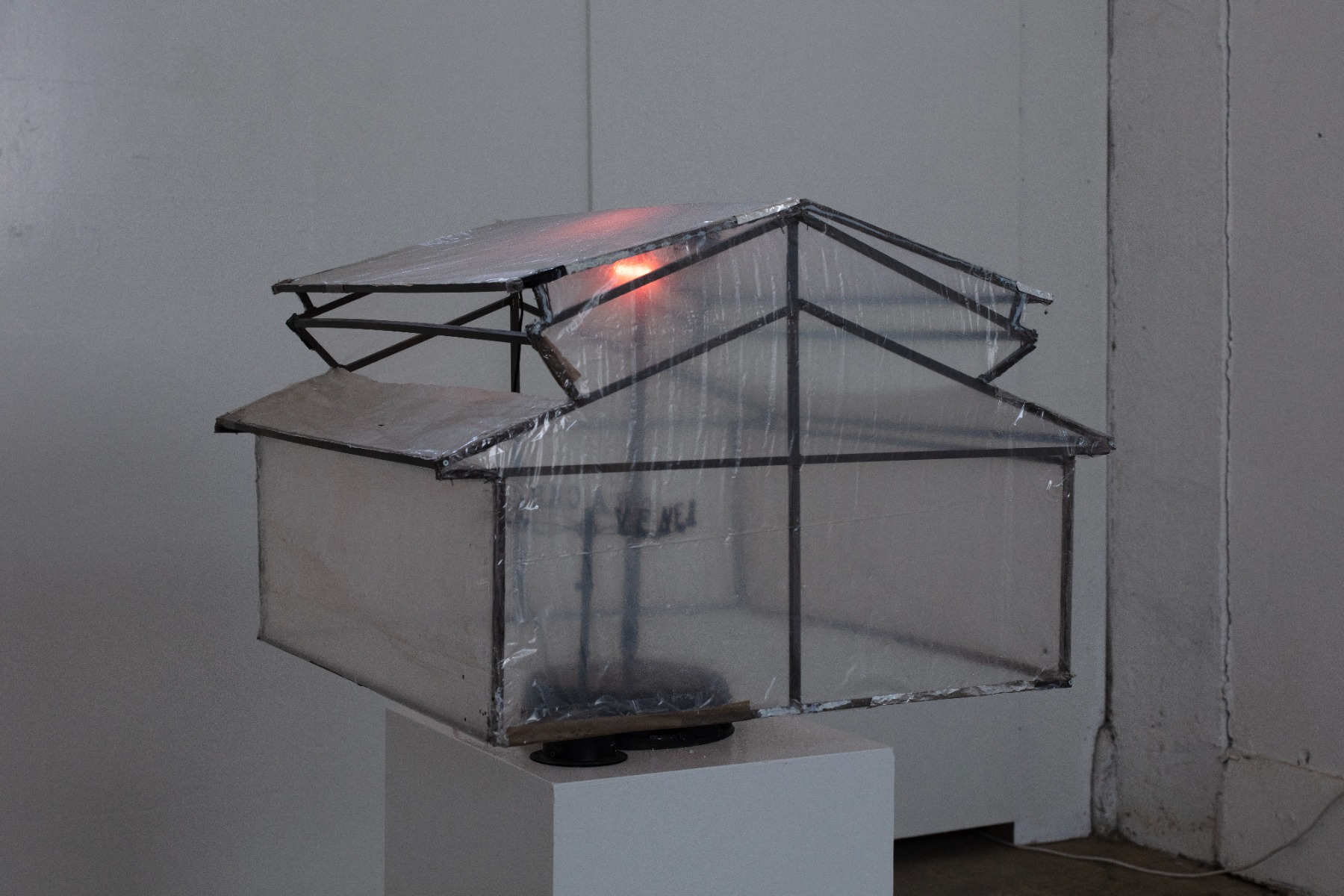
VW: When I was walking through the show, I was actually also thinking a lot about this greenhouse. Because there’s a lot of greenhouses in the Netherlands, and greenhouses are also an integral part of the landscape of Latvia. And then I was thinking about how it becomes this place of protection from weather conditions, etc.; it becomes kind of a refuge, a place for shelter. But maybe with us humans entering the greenhouse, doesn’t the disruptor enter the space? The proclaimed safe space is not a safer space anymore?
I don’t know; it’s just a really weird thought I was having.
BdB: Yeah, yeah, yeah. That I don’t know. I don’t know if I can say anything about that.
Because I didn’t think about it in that way.
VW: Yeah, you also don’t have to say anything about it. Talking to you, it sounds like you conceptualised the greenhouse more as a place and space. And I just thought more about people entering this place. Another element you used for this exhibition are scale models, which are commonly used in architecture to depict or explore different possibilities of future projects. But your scale models look rather dystopian. And then there’s specifically this gray one that proclaims that everything is okay. This scale model reminds me of the scenery for maybe a science fiction movie. I was wondering what actually inspires to create these dystopian models.
BdB: Well, I am really interested in scale models, but they always present an ideal world, and we don’t live in an ideal world. We live in a world where there’s a lot of trouble and turbulence. I wanted to make constructions that are not meant for living; the work should look like something that is not nice or good to live in as a human. So the construction is there, but what’s the role of it? What’s the function of it? I tried to make that a bit unclear, so it becomes an object with no clear functions. I would not like to live in that.
I wanted to counter this utopian way of presenting, because, well, we all know that the world is not like the maquettes we see on billboards. I often see these impressions of new buildings with nice trees around them and kids playing in the grass, and that’s also a world. But when you eventually see the building, it can be quite different from what they try to sell you. I’m commenting on that because I think a lot of the ways we construct our cities nowadays are not always good for the people that will use them.
Bas de Boer, “Shelter” (29.05. – 29.05.2024) at TUR_telpa. Photo: Kristīne Madjare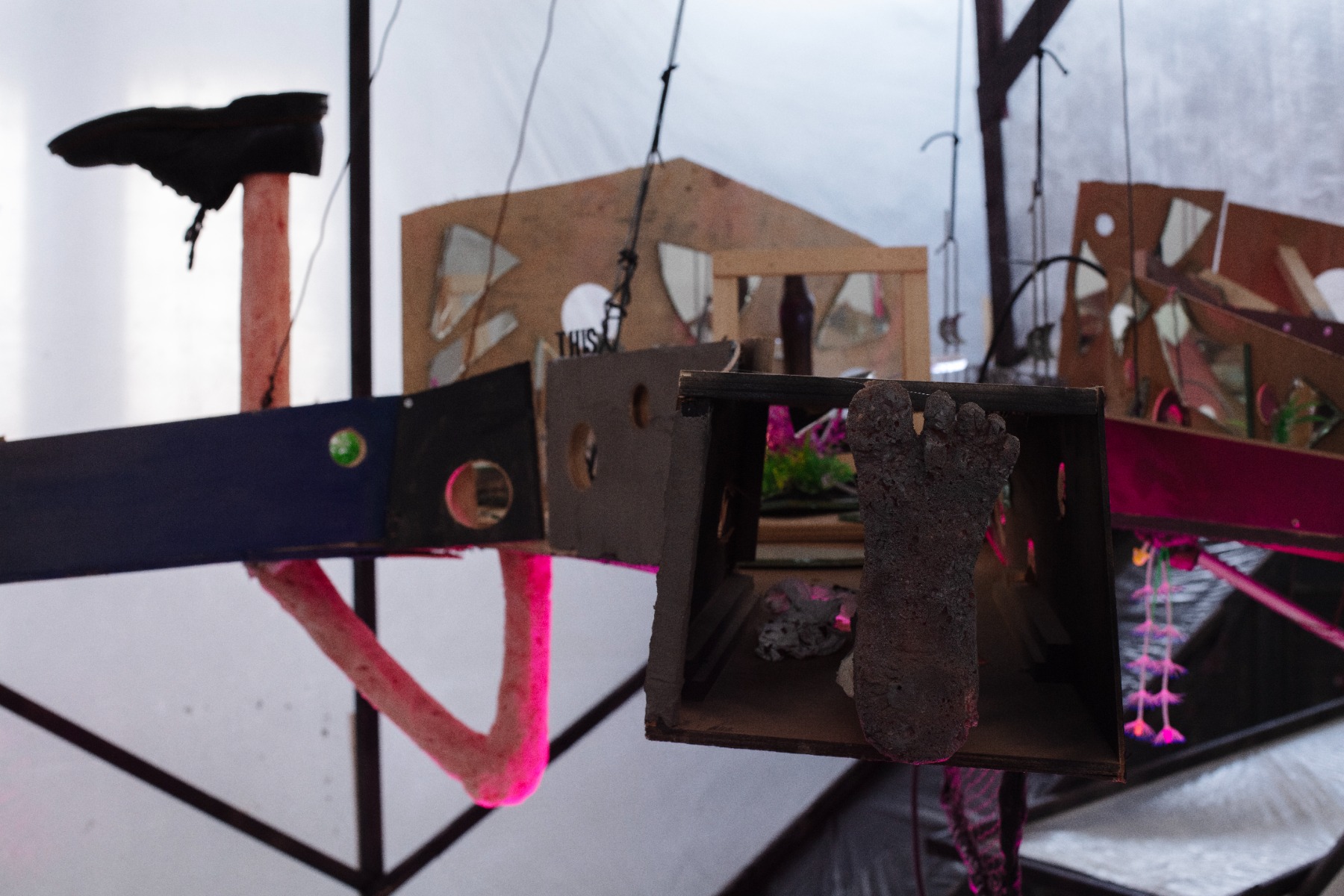
VW: Yes, I sadly agree with that. In this exhibition, to create your work, you use a lot of very different materials. There’s wood, foil, and foam, but you also use these little plants, for example, that I think are meant to decorate aquariums. Where do you find these materials, and why do you use them specifically?
BdB: Well, to begin with the plants: This pink light in the greenhouse is a growing light, so it’s especially designed; it has a certain color, which they have in greenhouses in the Netherlands. So it’s really to have a certain flaring light, which is good for growing. There’s that nourishment part; it’s like a sign of affection that you give, a sort of fake love, where you have this not-natural sunlight, and it’s plastic, of course, so there’s nothing going to grow there. The outer shell of the greenhouse and what was in there should be connected, so that’s why I used this plastic plant.
Regarding the materials I use, I always like to work quickly. I always like when people make a very short or quick sketch, so you see the directness of the action in it. I try to keep my work like it’s not completely finished; it should have that sketch-like quality. Then it becomes, for me, vital or alive, instead of becoming like a design. I like the quickness of working.
You’re allowed to see how things are, because that’s also important. You can see how the cables go and how the electricity is connected. I don’t want to take that all away; it’s all part of it. It’s not a screen or a theatre where you create the illusion; it’s all there, and I’m not going to hide it or try to make it nicer than it is.
VW: That makes sense.
BdB: Here I made everything from cardboard, plywood, and little sticks. But to make this one piece - I wanted it to be one structure - I decided to add cement to give it a concrete feeling, and then it becomes really one, one piece.
Bas de Boer, “Shelter” (29.05. – 29.05.2024) at TUR_telpa. Photos: Kristīne Madjare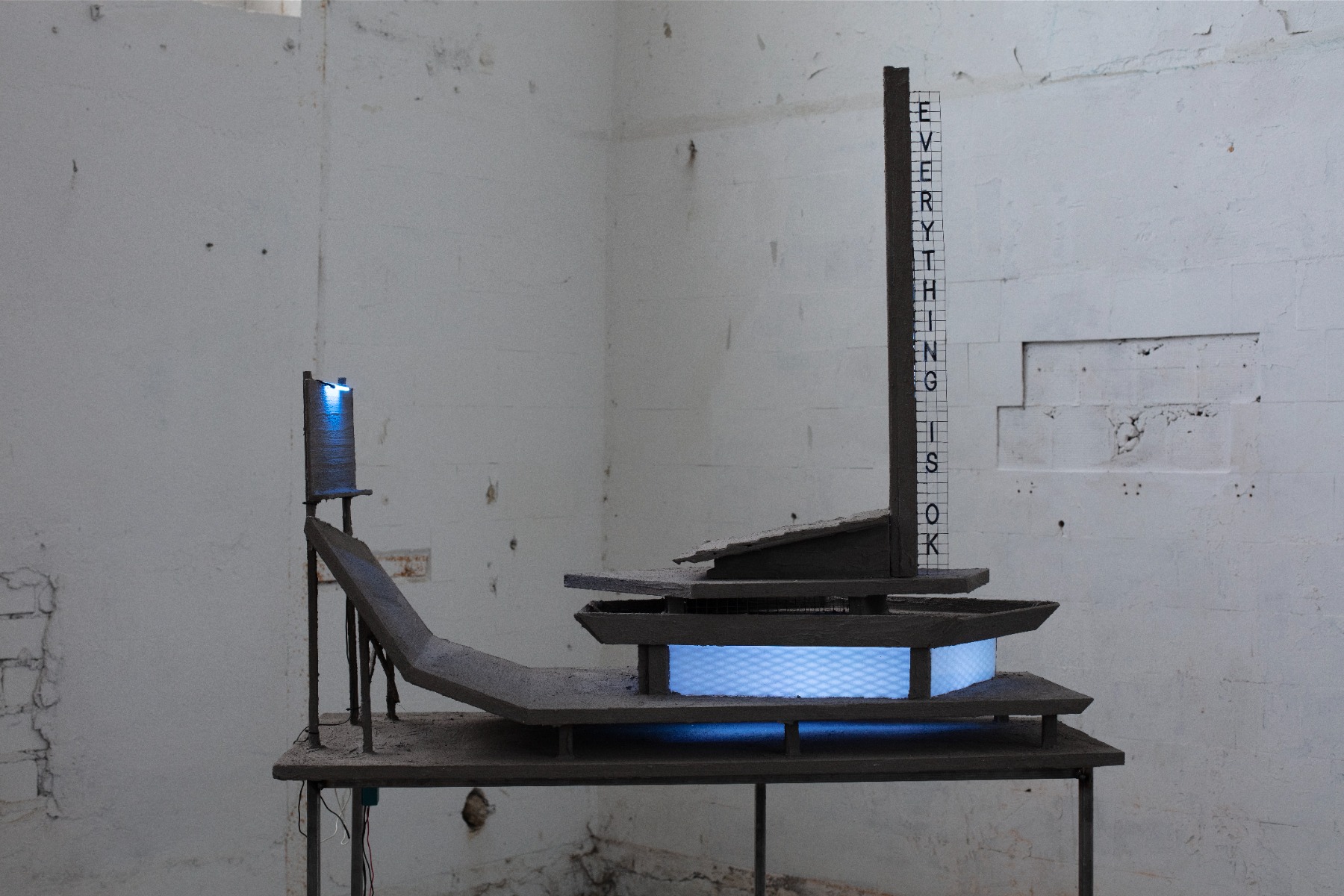

VW: There’s also this video in the exhibition, and the video seems quite important to your practice, because if I understood it right, then you record your work every time, and you add the documentation footage to the video. Then the video is the only thing left of the work. So why this process, and how did you end up coming to this process?
BdB: Well, as everybody that is, I guess, involved with making stuff, you make it in a certain gallery at a certain moment, and after that, it disappears. You take down the work; it dissolves into the garbage bag, into your studio leftovers. And like now, there is someone documenting the work, because after this, if I take it down, it’s not there anymore. So documentation became a part of my work. Because I don’t keep my work. I recycle it; I throw it away. So the only thing that remains is this documentation. I had so much documentation about all the works and I want to give people a context of all the works, so they can see this is one work in a line of many works. I decided to make a compilation video where all this documentation is put in, so people can see fragmented parts of earlier works.
You get the idea that this is not a single work; this is part of a bigger body of work.
VW: Yes, I feel like the video is actually quite interesting, because it makes it clear that there’s a continuity. I really enjoy that. Sometimes, within the show, you refer to the end. There is this one work that says, ‘true love will find you at the end’. There is also this little sausage in the bucket that says ‘the end’. Why is the end so important, and what happens at the end?
BdB: Well, what is the end? That may be a good question. I ask questions, but I don’t have answers. ‘True love will find you in the end’ is, I think, the best song ever written and recorded by Daniel Johnson. Maybe you know the song. I think it’s the best song ever written. I like the text because ... you can explain it in many ways. It’s lovely to say, but it’s also sinister. It can be sarcastic or cynical. For me, everything within that line exists, and that’s also fine. And I had this other work where this shark swam in this inflatable swimming pool. Those are two separate works that I combined together, because I really think this could work together with this text. I didn’t construct this thing; I found it. It’s like a thing you have on your wall where there’s a fountain and there’s lights, so this whole technical insight was already there. I only took off the cover, and I put the video in. And I added the text to it, so it’s a sort of ready-made in that sense.
It was an experiment, as many of my works are. I don’t like to have a very clear idea and just execute it. I like it if I start with something and it goes in a direction that I had not foreseen. And that happened with this work. I never had the idea of, I will build this, or I’m going to make this, but it became a thing. I’m experimenting with three-dimensional things, and sometimes good comes out of it. Personally, I like this work. But most of the time, it’s just crap, and it’s not good. And the other one, the bucket, was also just an experiment. I had a bucket, and I had a mirror that fit in it. So I added it to the show last, and it first shouldn’t be part of the show. Because the other works, I thought about them, but this was the last one. And because this mirror is at the bottom of this bucket, it gives you the feeling that you’re at the end of the tunnel. So I wanted to make a joke about that.
Bas de Boer, “Shelter” (29.05. – 29.05.2024) at TUR_telpa. Photos: Kristīne Madjare
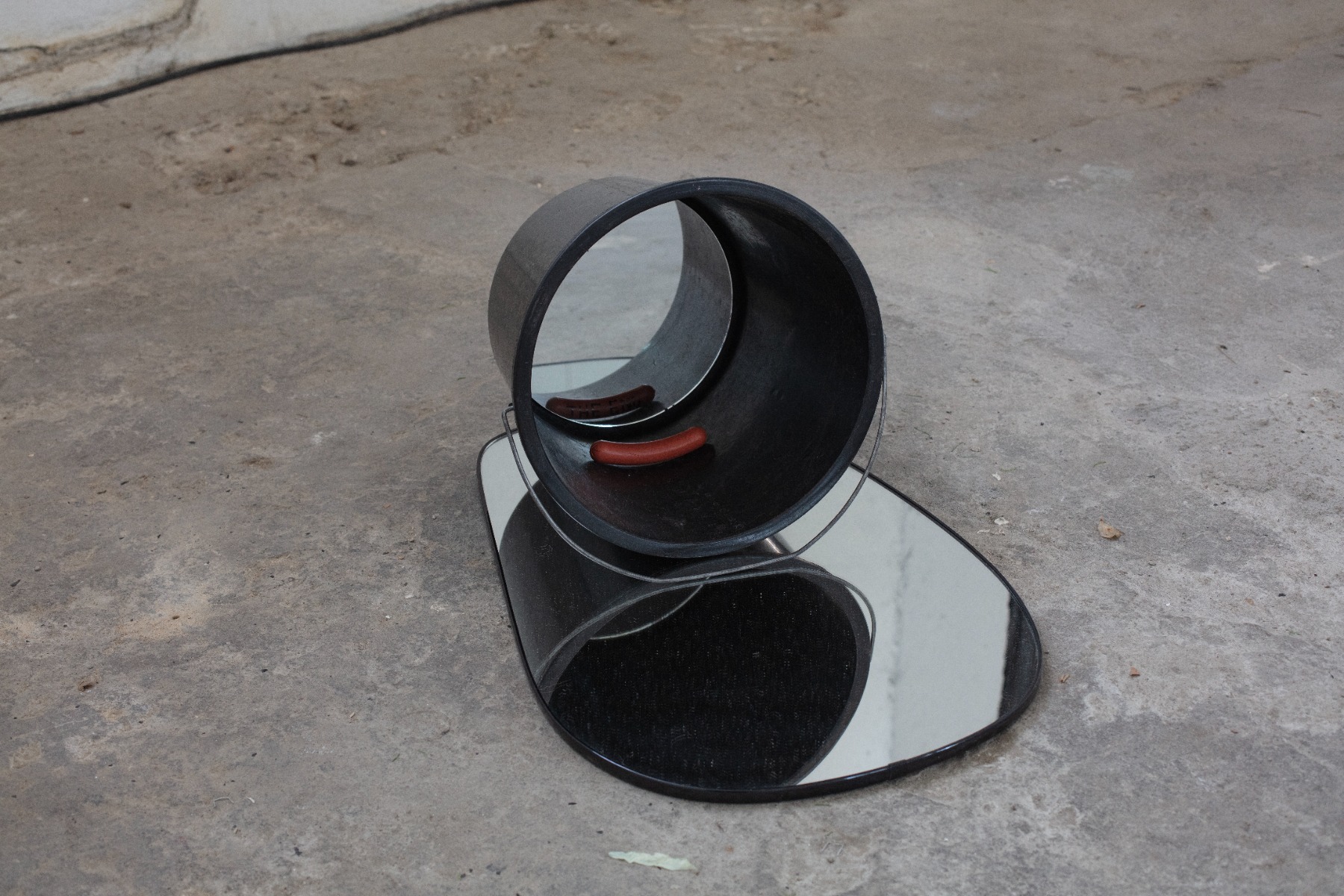
VW: Nice. Maybe you can tell me a bit more about the process of selecting the pieces for the show. This exhibition was curated by Edd Schouten, and you’re both from The Hague, and you both know each other for many years and maybe would also consider each other friends. So I was wondering, how was the process of working together on this show?
BdB: Yes, it was good. I notice with myself that I really need some privacy to work when installing. Edd is a curator, and I’m always a bit afraid of feedback from people, because I might just want to do it my own way. But in the end, we had some good talks, and he made some good decisions. That was nice, because sometimes you cannot see it yourself anymore because you’re in this process all the time. It’s nice if an outsider, not completely, of course, but somebody else has another look at it, and you have a discussion. So in the end, it was very important for the placement of the work. So yeah, it worked very nicely. I know Edd from The Hague. We have quite some mutual friends, but we started hanging out more, actually, here in Riga than in The Hague.
VW: It’s really nice to see how these connections sometimes develop.
BdB: Yeah, yeah, for sure.
VW: Then maybe, as a last question: Is everything really okay?
BdB: I don’t think so. No, I mean, we live in the best part of the world. So in that sense, everything is okay. Especially if you see what’s now going on in Palestine, Ukraine, and so many other countries that are unbelievably suffering. So in that sense, yes, everything is okay, but everything is completely not okay. Because, yeah, I am worried about a lot of things. So this is a cynical billboard text. It’s also commenting on the utopian advertisements you see, like people are happy, and if you brush your teeth, you will have this white, shiny smile, and I don’t buy it.
Title image: Bas de Boer, “Shelter” (29.05. – 29.05.2024) at TUR_telpa. Photo: Kristīne Madjare